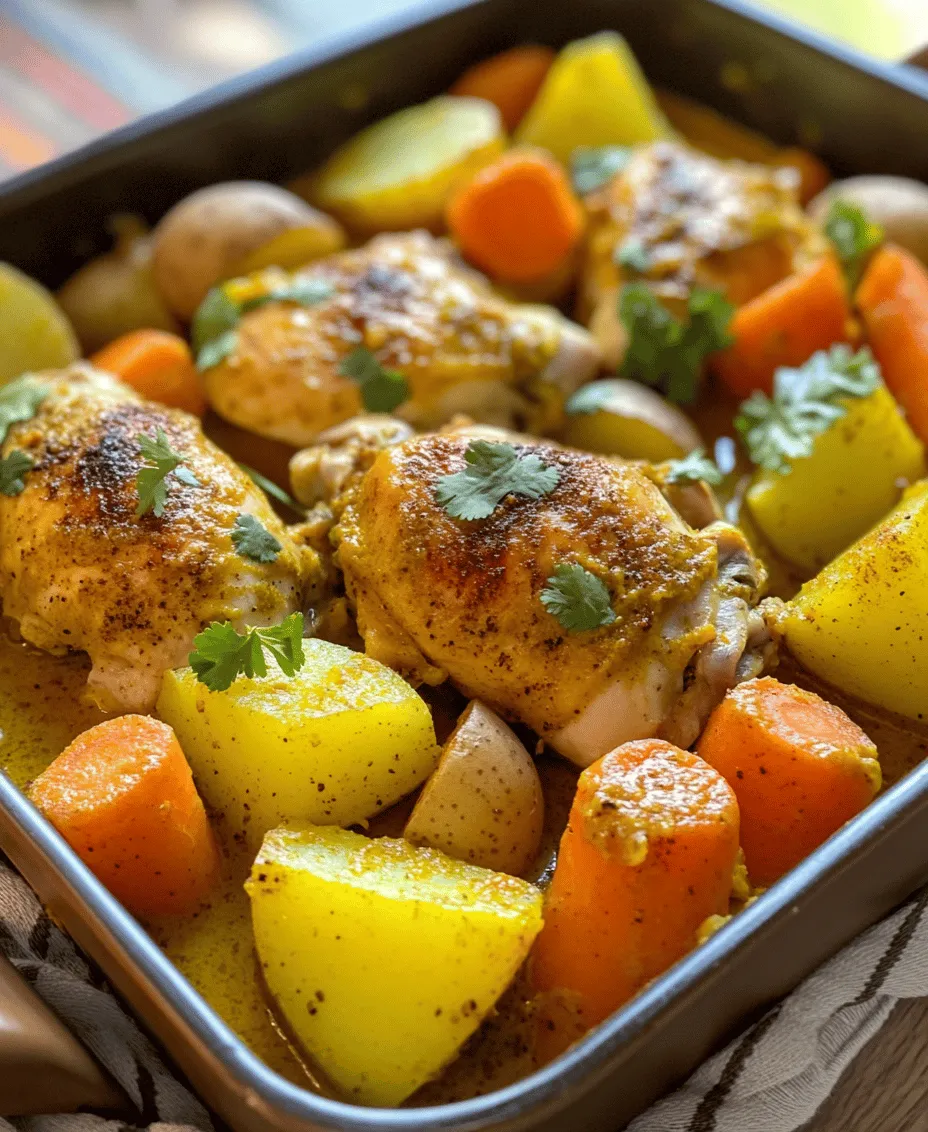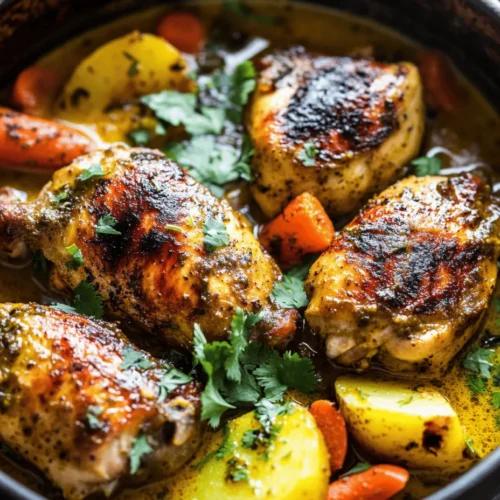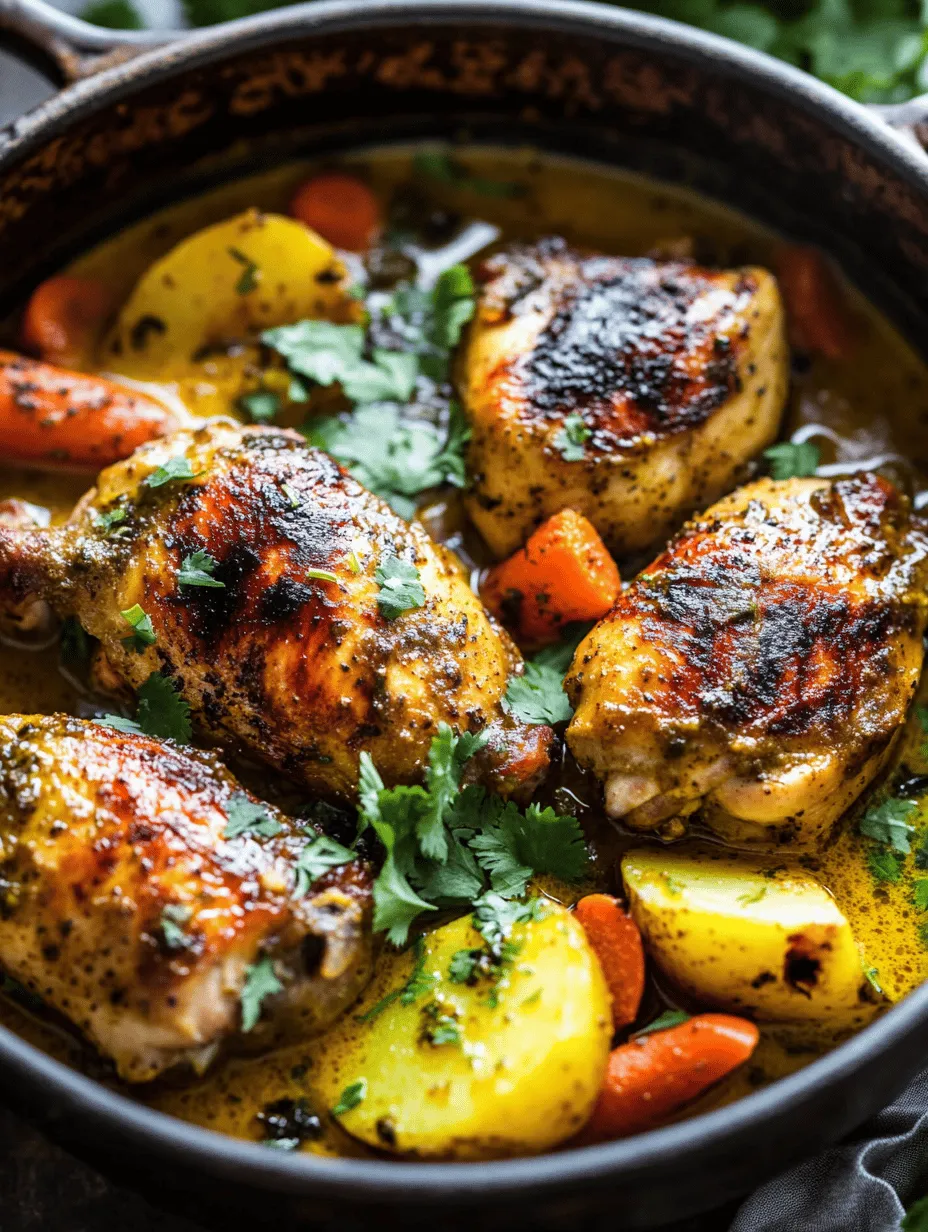Introduction
Jamaican cuisine is a vibrant tapestry of flavors, deeply rooted in the island’s rich history and cultural influences. This culinary tradition reflects a blend of African, European, Indian, and indigenous Taino cooking techniques and ingredients. Each dish tells a story, and one of the most beloved staples in Jamaican households is curry chicken. This dish not only showcases the unique flavors of the Caribbean but also serves as a symbol of community and family gatherings, often enjoyed during special occasions and Sunday dinners.
Jamaican curry chicken is not just about the chicken; it’s a celebration of spices and aromatic ingredients that come together to create a dish bursting with flavor. The use of Jamaican curry powder—a vibrant yellow blend of spices including turmeric, coriander, and cumin—sets this dish apart from other curry variations. Add to this the warmth of allspice, known locally as pimento, and you have a culinary masterpiece that captivates both the palate and the senses.
In this article, we will explore the authentic Jamaican curry chicken recipe, diving into its cultural significance, the unique ingredients that make it special, and the preparation steps that ensure a flavorful dish every time.
Understanding Jamaican Curry Chicken
Description of Traditional Jamaican Curry Chicken
Traditional Jamaican curry chicken is a hearty dish that features tender pieces of chicken simmered in a richly spiced sauce. The preparation typically involves marinating the chicken in a blend of spices that infuse deep flavors into the meat. The dish often includes vegetables such as carrots and potatoes, which not only add nutritional value but also contribute to the overall texture and satisfaction of the meal.
The golden hue of the curry sauce, combined with the aromatic scent wafting through the kitchen, makes this dish a favorite among many. Served with rice and peas or steamed vegetables, Jamaican curry chicken is a comforting meal that warms the soul.
The Origins of Curry in Jamaican Cooking
The introduction of curry to Jamaican cuisine can be traced back to Indian indentured laborers who arrived on the island in the 19th century. They brought with them their culinary traditions, including the use of various spices and cooking techniques. Over time, these influences melded with local ingredients and cooking styles, leading to the unique Jamaican curry we know today.
Curry has become a significant part of Jamaican culture, often associated with family gatherings and community celebrations. It is a dish that embodies the spirit of togetherness, making it a staple in many households across the island.
The Importance of Spices
Spices play a crucial role in Jamaican curry chicken, with Jamaican curry powder and allspice being the stars of the show. Jamaican curry powder is distinct from other curry blends, as it often includes fenugreek and a higher concentration of turmeric, giving it a unique flavor profile and color. Allspice, on the other hand, has a warm and aromatic quality that enhances the overall taste of the dish.
These spices not only contribute to the flavor but also offer numerous health benefits. Turmeric, for instance, is renowned for its anti-inflammatory properties, while allspice is rich in antioxidants. Together, they create a dish that is both delicious and nourishing.
Ingredients Overview
Detailed List of Ingredients
To prepare authentic Jamaican curry chicken, you will need the following ingredients:
– Chicken: The star of the dish. Opt for bone-in, skinless chicken pieces for the best flavor and tenderness.
– Jamaican Curry Powder: Essential for that authentic flavor. Look for a blend that includes turmeric, coriander, and cumin.
– Allspice: Adds warmth and depth to the dish, enhancing the overall flavor experience.
– Onion: Provides a sweet and savory base for the curry sauce.
– Garlic: A key aromatic that adds depth and richness to the flavor profile.
– Ginger: Offers a warm spiciness that complements the other ingredients.
– Carrots: Contributes sweetness and texture to the dish.
– Potatoes: Absorb flavors and add heartiness to the meal.
– Scallions: Provide a fresh, green note that brightens the dish.
– Coconut Milk: Adds creaminess and richness, balancing the spices beautifully.
– Broth: Enhances the dish’s flavor and provides the necessary liquid for simmering.
– Scotch Bonnet Peppers: Adds heat. Adjust the quantity to suit your personal spice tolerance.
Chicken: Benefits of Using Bone-In, Skinless Chicken
When it comes to chicken for curry, using bone-in, skinless pieces is highly recommended. Bone-in chicken retains moisture during cooking, resulting in tender and juicy meat. The bones also enhance the flavor of the curry sauce as it simmers, contributing to a richer and more complex taste. Skinless chicken helps to keep the dish lighter, allowing the spices and aromatics to shine without the added fat from the skin.
Spices: Significance of Jamaican Curry Powder and Allspice
Jamaican curry powder is a unique blend that sets this dish apart from other curry variants. It typically includes a combination of spices such as turmeric, coriander, cumin, and sometimes fenugreek, which contributes to its distinctive flavor and vibrant color. The allspice, or pimento, offers a warm, aromatic profile reminiscent of cloves, cinnamon, and nutmeg—all in one spice. Together, these spices form the backbone of authentic Jamaican curry chicken, infusing it with rich flavors that are both bold and comforting.
Aromatics: Role of Onions, Garlic, and Ginger
Aromatics are essential in developing the flavor base for Jamaican curry chicken. Onions add sweetness and depth, while garlic provides a savory punch. Ginger contributes warmth and a slight spice that complements the curry spices beautifully. Sautéing these aromatics at the beginning of the cooking process allows their flavors to meld and deepen, creating a robust foundation for the dish.
Vegetables: Nutritional Value and Texture
Carrots and potatoes are commonly used in Jamaican curry chicken, adding both nutritional benefits and pleasing texture. Carrots are high in vitamins A and C, while potatoes provide carbohydrates for a hearty meal. Both vegetables absorb the flavors of the curry sauce, enhancing their taste and making them a delightful addition to the dish. Scallions, added at the end of cooking, provide a fresh burst of flavor and color, enhancing the overall presentation.
Broth and Coconut Milk: Enhancing Creaminess and Flavor
Coconut milk is a quintessential ingredient in many Caribbean dishes, including Jamaican curry chicken. It adds a rich, creamy texture that balances the spices and enhances the overall flavor of the dish. The broth, whether chicken or vegetable, provides the necessary liquid for simmering, ensuring that the chicken is tender and infused with flavor. The combination of coconut milk and broth creates a luscious sauce that clings to the chicken and vegetables, making every bite a delight.
Scotch Bonnet Peppers: Adjusting Heat Levels
Scotch bonnet peppers are a hallmark of Jamaican cooking, known for their intense heat and fruity flavor. When incorporating these peppers into your curry chicken, it’s essential to adjust the quantity based on your spice tolerance. If you prefer a milder dish, you can remove the seeds and membranes before adding the peppers, as these parts contain the most heat. Alternatively, you can use less pepper or substitute with a milder chili for a gentler flavor profile.
Preparation Steps for Authentic Flavor
Marinating the Chicken
The first step in preparing authentic Jamaican curry chicken is marinating the chicken. Marination is crucial for infusing the meat with flavor and ensuring it becomes tender during cooking. A simple marinade typically includes Jamaican curry powder, allspice, garlic, ginger, and a bit of salt and pepper.
Suggested Marination Times for Best Results
For optimal flavor, marinate the chicken for at least 1 hour, but if time allows, aim for 4 to 24 hours. Marinating overnight will yield the best results, allowing the spices to penetrate deeply into the chicken, resulting in a more flavorful dish.
Sautéing Aromatics
Once the chicken is marinated, the next step is to sauté the aromatics. In a large pot or Dutch oven, heat some oil over medium heat and add chopped onions, garlic, and ginger.
Techniques for Sautéing to Achieve the Right Flavor Balance
Sauté the aromatics until the onions become translucent and fragrant, which typically takes about 5-7 minutes. Be careful not to burn the garlic, as this can impart a bitter taste to the dish. The goal is to achieve a balance of sweetness from the onions and warmth from the garlic and ginger.
Benefits of Cooking Aromatics Before Adding Chicken
Cooking the aromatics before adding the chicken allows their flavors to develop fully and creates a rich base for the curry sauce. This step ensures that the spices and aromatics are well incorporated into the dish, resulting in a more cohesive flavor profile.
Browning the Chicken
After the aromatics are sautéed, it’s time to add the marinated chicken to the pot. Brown the chicken pieces on all sides, which takes about 5-10 minutes. This step not only enhances the flavor through the Maillard reaction but also helps to seal in the chicken’s juices, keeping it moist during cooking.
As the chicken browns, it will pick up the flavors from the aromatics and spices, setting the stage for the rich curry sauce that will follow. Once browned, the next steps will involve adding the remaining ingredients, simmering, and allowing the flavors to meld beautifully.
Stay tuned for the next part of the article, where we will continue with the preparation steps and explore how to finish this delightful dish, ensuring every bite is a true taste of Jamaica.

Browning Process and Its Impact on Flavor
Browning the chicken is a crucial step in preparing authentic Jamaican curry chicken, as it enhances the dish’s overall flavor profile. This process, often referred to as “searing,” involves cooking the chicken at high heat to create a flavorful caramelized crust. The Maillard reaction, which occurs when proteins and sugars in the meat are exposed to heat, results in a rich, deep color and an irresistible aroma that adds complexity to the dish.
To achieve a perfect sear, it’s essential to ensure that the chicken pieces are patted dry before cooking. Excess moisture can inhibit browning and cause steaming instead. Additionally, heat your pan adequately before adding the oil and chicken; this will help create a quick sear that locks in the juices. Depending on the size of your chicken pieces, allow them to cook undisturbed for several minutes before flipping them to ensure maximum browning.
Building the Curry
Adding Vegetables and Liquids
Once your chicken is beautifully browned, it’s time to build the curry. Start by adding your chopped onions, garlic, and ginger to the pan. These aromatics will create a fragrant base, infusing the dish with rich flavors. Sauté the vegetables until they become translucent, allowing their natural sweetness to develop. Next, add your chopped bell peppers and carrots, stirring to combine.
This layering technique is essential, as each vegetable contributes unique flavors and textures to the curry. For instance, bell peppers add a slight sweetness, while carrots provide a subtle earthiness. After the vegetables have softened, pour in your coconut milk and chicken broth. The coconut milk will lend creaminess and a hint of sweetness, balancing the spices in the dish.
Importance of Layering Flavors with Vegetables
Layering flavors with vegetables is pivotal in creating a well-rounded curry. Each ingredient interacts with the spices and chicken, enhancing the overall dish. For example, adding tomatoes or potatoes can provide additional body and help thicken the sauce, while leafy greens like spinach can add a fresh note when added towards the end of cooking.
Tips for Incorporating Broth and Coconut Milk Effectively
To incorporate the broth and coconut milk effectively, pour them in gradually, scraping the bottom of the pan to deglaze any flavorful bits left from browning the chicken. This step ensures that no flavor is wasted and creates a rich, cohesive sauce. After adding the liquids, stir in your curry powder, thyme, and any additional spices you desire.
Be sure to taste the mixture at this stage; you can adjust the seasoning with salt, pepper, or additional spices to suit your palate.
Simmering the Curry
Explanation of Simmering and Its Role in Tenderizing Chicken
Simmering is a gentle cooking method that allows flavors to meld while tenderizing the chicken. Once your curry reaches a gentle boil, reduce the heat and let it simmer for about 30-45 minutes. This cooking time allows the chicken to absorb the spices and flavors from the broth and coconut milk, resulting in a tender, flavorful dish.
During this time, the chicken will become succulent, and the curry sauce will thicken as it reduces. You can stir occasionally to prevent sticking and ensure even cooking.
Adjusting Seasoning and Consistency for Optimal Taste
As the curry simmers, it’s important to taste and adjust the seasoning. If the curry is too thick, feel free to add a splash more broth or water. If it’s too thin, allow it to simmer uncovered for a little longer to reduce and thicken.
This is also the time to make any final adjustments to the flavors; perhaps a pinch more salt or a touch more curry powder. Remember, each ingredient contributes to the final taste, so don’t hesitate to experiment until it’s just right.
Finishing Touches
Removing Scotch Bonnet for Heat Control
Once your curry chicken is cooked to perfection, it’s essential to address the Scotch bonnet pepper. If you prefer a milder dish, carefully remove the Scotch bonnet before serving. This pepper is known for its heat level, and removing it allows you to control the spice level of the dish. If you like it hot, you can leave it in, but be mindful of those who may prefer a milder taste.
Tips for Adjusting Sauce Thickness
If you desire a thicker sauce, you can mash a few pieces of the cooked carrots or potatoes against the side of the pot to release their starch. Alternatively, you can mix a tablespoon of cornstarch with cold water to create a slurry, which can be stirred into the curry and cooked for a few additional minutes until thickened.
Presentation and Garnishing with Fresh Cilantro for Visual Appeal
Presentation is key to any dish, and garnishing your curry chicken with fresh cilantro not only adds a pop of color but also enhances the flavor. Simply sprinkle a handful of chopped cilantro over the dish just before serving for an aromatic touch that complements the spices beautifully.
Serving Suggestions
Traditional Accompaniments for Jamaican Curry Chicken
When it comes to serving authentic Jamaican curry chicken, there are several traditional accompaniments that elevate the meal. The most popular pairing is steamed white rice, which absorbs the delicious curry sauce beautifully, providing a satisfying contrast to the robust flavors of the chicken.
Serving Over Rice, with Roti, or Alongside Fried Plantains
Another fantastic option is to serve the curry over a bed of fluffy rice and peas, which adds an additional layer of flavor and texture. Alternatively, you can serve the curry with warm roti, a soft flatbread that is perfect for scooping up the chicken and sauce. Fried plantains also make a delightful side; their sweetness balances the savory spices of the curry.
Suggestions for Side Dishes that Complement the Meal
In addition to the aforementioned sides, consider pairing your curry chicken with a fresh salad or coleslaw for a refreshing contrast. A simple cucumber salad dressed with lime juice and salt can cut through the richness of the curry, providing a bright, zesty flavor.
Nutritional Information
Overview of Nutritional Benefits of the Dish
Authentic Jamaican curry chicken not only tantalizes the taste buds but also offers a well-rounded nutritional profile. The chicken provides a healthy dose of protein, which is essential for muscle repair and growth. The inclusion of vegetables adds fiber, vitamins, and minerals that contribute to overall health.
Discussion of the Balance of Protein, Vegetables, and Healthy Fats
The coconut milk adds a source of healthy fats, which are vital for nutrient absorption and provide a creamy texture that makes the dish indulgent yet nutritious. The combination of protein from the chicken, fiber from the vegetables, and fats from the coconut milk creates a balanced meal that satisfies hunger while providing essential nutrients.
Cultural Significance of Curry Chicken in Jamaica
Exploration of How Curry Chicken Fits into Jamaican Celebrations and Family Gatherings
Curry chicken holds a special place in Jamaican culture, often featured at family gatherings, celebrations, and festive occasions. Its rich flavors and comforting qualities make it a beloved dish served during Sunday dinners, holidays, and special events.
Personal Anecdotes or Stories Related to the Dish’s Place in Jamaican Culture
Many Jamaicans have fond memories of gathering around the dinner table, sharing stories and laughter over a warm pot of curry chicken. The dish evokes a sense of home and tradition, symbolizing the importance of family and connection in Jamaican culture.
Conclusion
In conclusion, authentic Jamaican curry chicken is not just a dish; it’s a culinary experience that brings together rich flavors, cultural significance, and nutritional benefits. From the browning process to the final garnishing, each step contributes to creating a delicious meal that embodies the spirit of Jamaican cuisine.
Whether you’re celebrating a special occasion or simply craving a taste of the Caribbean, trying your hand at this recipe is sure to impress. So gather your ingredients, follow the steps, and enjoy the vibrant flavors of Jamaica in your own kitchen. Indulge in the warmth and comfort of this beloved dish, and let it transport you to the sunny shores of the Caribbean.



